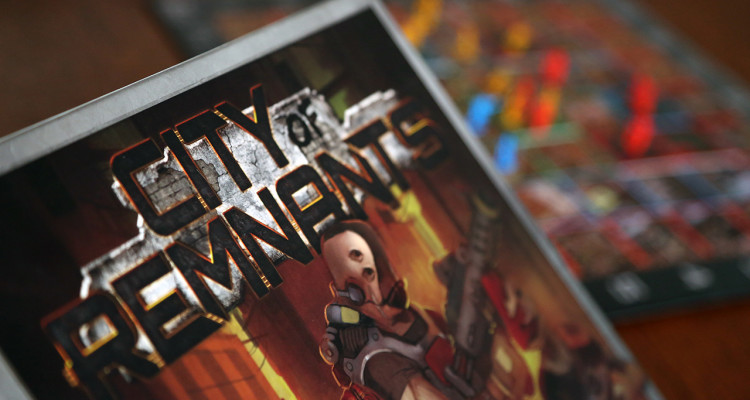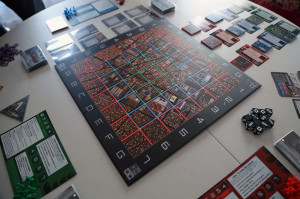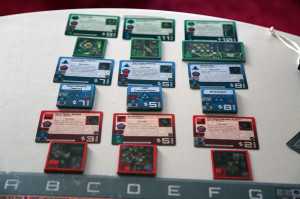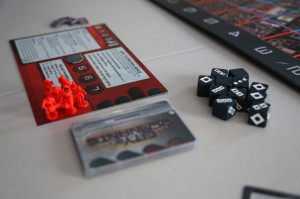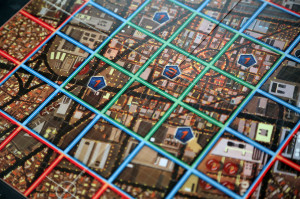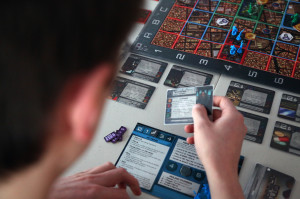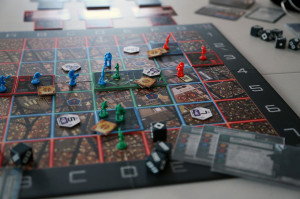INTRODUCTION
Amongst the ruin and decay of a space-age ghetto, you and your fellow rebels battle for control of what little space and resources are left. While your gang of loyal followers and guns-for-hire struggle to maintain dominance over your enemies, the entire population shares a similar fate – the Yugai, an invasive (robot-ish) alien race, have enslaved you within the walls of a congested city. In City of Remnants, you and up to three other players will actively struggle to survive amidst rival gangs and oppressive Yugai patrols.
DESIGN
City of Remnants is a competitive game for 2 to 4 players, designed by Isaac Vega (Bioshock Infinite: Siege of Columbia) and Colby Dauch (Summoner Wars) and published by Plaid Hat Games (Summoner Wars, Dungeon Run, Bioshock Infinite, Mice and Mystics). It utilizes a number of well-known game mechanics in combination to provide a vast array of different strategies for gaining the most Renown (victory) points. Players will actively vie for area-control, fight battles using dice and cards, deck-build, and manage resources/money to achieve their goals. Estimated time to play is 60-90 minutes. Our games have been around 120 minutes, but with more experience 90 minutes should be doable.
City of Remnants drags you into the game’s theme from the first time you see it. The thick and sturdy game box looks like something you’d pawn for a few extra ARCs (Alien Refugee Credits, the in-world currency) or some ammo for your defense drone. The cover portrays four well-armed refugees prepared to kill or be killed. It suggests a certain level of grit and dismay that surrounds the sad truth of this game – you’re struggling to survive and often tearing down other refugees in your path to do so.
When you crack it open, you find that the dark exterior masks a treasure-trove of cards, tiles, chits, and miniatures. With 130+ cards, 64 plastic miniatures (with a variety of custom sculpts), 10 custom dice, a two-sided game board and somewhere around 200 tokens, you are certainly getting your money’s worth – even at the $65 MSRP. All of the components are made of quality materials and have held up well to multiple plays.
As stated before, City of Remnants employs a variety of game mechanics that piece together to form a cohesive experience. Each of these mechanics is generally its own self-contained element, but these different options will need to be strung together in a way that best benefits you and most hinders your opponent.
GAMEPLAY
The goal of City of Remnants is to have the highest Renown (victory points) at the end of the game, which is triggered when 200 total renown has been collectively claimed by the players. To gain renown, players will seek to develop and control various high-value areas around the city. Each game will provide a random set of “development tiles” – buildings – that can be constructed around the city and then used to produce money (ARCs) and renown. Once built, you can then occupy these building with your forces to begin reaping the benefits.
Set-Up
To begin City of Remnants, each player will first choose one of the four unique gangs to control. These range from the hard-hitting Red Gang to the well-funded Green Gang and every color theme in between (actually…just Yellow and Blue). An excellent variety of variable powers are found on the cards, but you’ll have to exercise some creativity if you want a cool name for your gang (DOScrimination, Circuitcision, Robotomy, The Red Team, etc.). With your gang’s individual strengths and weaknesses, you can plan to do what they do best or test your mettle and show that having you as a leader is your gang’s real strength.
Once you have your gang, you will be supplied a deck of 10 cards, a band of 7 thugs (minis) and your player board.
Your player board is the hub for your gang. It provides an outline of the round sequence, describes each action you can take, stores your gang member pool, indicates your influence and marks the number of actions you have left in a turn.
The city board will be set up and each player will choose an “entry zone.” This dictates where your units enter the city and will likely become the core of your gang territory. Within the city are three districts: the Slums (red), the Midtown (blue) and the Heights (green). Each district will have restrictions on what can be built there and how expensive it will be to develop.
To the side of the board will be the deck of free agent gang members, the black market and the available development tiles (choose 3 randomly for each district). In another area keep the Yugai patrol cards and the black bag of Yugai units. You can organize the rest of the components as you see fit, just make sure they’re all easily accessible.
Game Round
Reset Phase (Skip this phase on turn 1)
The game is played over a series of rounds where you and your opponents will alternate taking actions until each of you has completed four actions. Before you begin, though, you must first conduct the Reset Phase. During this phase, each player shuffles their discard pile and places it on the bottom of their deck. They then draw cards until their hand size equals their influence value and each player gains 2,000 ARCs. All of the currently face-up gang member and black market cards are discarded and four new cards are turned face-up in their place. Now you can begin your turn actions.
Turn Actions
On your turn, you can do one of six things as an action:
- Produce/Develop. As discussed above, your goal in City of Remnants will be to build and occupy different key areas around the city that will reward you with renown. To do so, you first need to develop these different facilities. A Produce/Develop action will allow you take one building from the supply and, after paying its ARC cost, place it on the board within the limitations of the specific building. Note: Once built, the development is considered fair-game to all players. Just because you built it, doesn’t mean you own it. A Produce/Develop action will also allow you to produce resources on the buildings you currently control, but this is done before you build (to prevent you from building and producing on the same development in the same action).
- Sell. Alien Refugee Credits (ARCs) make the City of Remnants go ‘round. Money is the key to gaining new gang members, buying developments, and improving your fighters with the latest technology. A Sell action will allow you to sell produced resources (up to your current influence value) for ARCs . The value of each resource is dictated by which development tile it was produced on.
- Buy. With such limited resources, any advantage is huge
for your gang. Having an extra smoke bomb on hand or even a leftover computer terminal can help keep your people alive long enough for you to maintain control. Unfortunately, there’s only one place to find that kind of tech – the Black Market. A Buy action will allow you to buy one face-up card from the black market for its ARC cost and place it in your hand. Additionally, you can buy renown points for 3,000 ARCs a piece (up to your influence value).
- Recruit. To keep control of your turf, and to take a little bit of your enemies’, you’ll need a crew that’s ready to fight. Roaming the streets are greenhorns and veterans alike, but you’ll be competing with rival gangs for their attention. A Recruit action will allow you to start an auction for one of the face-up gang members. In turn order, each other player may choose to bid or pass on that gang member, until all but one player has passed. The winning player pays the cost (this still costs the winning player an action if it wasn’t their turn), places the new recruit into his/her hand, and adds a new miniature to their gang member pool. If the original player did not win, that player begins a new auction for another gang member.
- Move. Once recruited, you’ll need to deploy your troops into the city to protect your interests and seize control of enemy territory. On a Move action, you may move a number of your minis (equal to your influence) up to 3 spaces each. You cannot move diagonally and each figure must finish its full move before moving another. Additionally, there can never be more than two units on a given space, including when moving through a space, unless you are ending on an enemy space to begin a combat.
- Refresh. Sometimes you need to gather the troops back at HQ and prepare for your next move. A Refresh action will allow you to discard as many cards from your hand as you’d like, shuffle your discard and place it on the bottom of your deck, and draw back up to your influence value.
Note: A player may play as many cards as he/she likes from their hand for their effect on their turn, without spending an action. A player never draws new cards unless a Refresh action or the Refresh Phase is triggered.
Yugai Patrol Phase
The illicit activities of your gang are certain to draw the attention of your robo-masters and their patrols. Each round, after all actions have been taken, the players will draw two Yugai Patrol cards and place Yugai unit markers (randomly chosen from the black bag) onto the specified coordinates. These units will now be active until the next round, where they will be discarded at the beginning of the next Yugai Patrol Phase.
Any player with units sharing a space with a Yugai Patrol unit will immediately enter into combat. Once all combats have been resolved, this phase is complete. Remaining patrols just keep….patrolling.
Combat
There are two instances in which a combat will occur:
1. A player’s figure shares a space with a newly placed Yugai Patrol unit
2. A player’s figure ends its move action in a space with one or more enemy units (including Yugai Patrol units).
Once a move action is fully complete (all figures have moved), a combat will occur in every space that currently has more than one player’s units contesting control for that space. Fighting these battles is a multi-step process.
- Select. Choose a number of unit cards (up to your influence value) from your hand that you will send into battle. Each unit card has a different battle value when fighting for your gang. Note: You may also choose to play cards blindly from the top of your deck into the battle, respecting influence limits.
- Reveal. Reveal these chosen cards and trigger any cards with a “Battle Effect.”
- Total. Add up the total battle value of your chosen unit cards.
- Roll. Roll one battle die for each figure you have in and orthogonally adjacent to the contested space.
- Add. Add it all up. Each symbol rolled on a battle die contributes one extra battle value to the total.
The winner of the battle is the one with the highest total battle value after those steps (defenders win ties). The loser must remove a figure from the contested space and permanently remove one of the unit cards they played in that battle from the game. If the space remains contested, do it again.
Renown Phase
You fought hard and lost some good fighters, but ultimately were able to secure new territory and defend your people. Or maybe you attempted to infiltrate your enemy’s area and got slaughtered. Either way, it’s now time to reap the rewards of your bravery (or misfortune). In this phase, players are awarded renown according to board spaces and developments that they currently control. To control a development, you need to have at least one unit in each space that the development covers. Once 200 total renown has been claimed, the player with the most is considered the most influential gang in the City of Remnants! (Congratulations and have fun dealing with all that Yugai attention!)
OVERALL EXPERIENCE
City of Remnants has a lot going on, but I knew that going in. Before purchasing, I had watched Rodney Smith’s tutorial and the Shut Up and Sit Down review several times. I wanted this game, so I was prepared.
That being said, it was still a bit of an uphill climb when I first cracked the box. The rules are written concisely and supported well with graphics and diagrams, but I still found myself relying on the rulebook and internet FAQs to clarify some of the finer details, even after a few games. Plaid Hat has taken the brilliant step of bringing on Rodney Smith for their video tutorials, but with this game it just didn’t feel like enough.
I think some of my unease with City of Remnants may actually be a result of its surprising amount of depth. Area control, deck building, bidding, money and resource management, economy building and a fully developed combat system with cards AND dice…Whew. Did I mention there’s a lot going on in City of Remnants?
This game is all about trial by fire. It’s about as difficult to grasp strategically as dodging Yugai Patrols may actually be. Where to focus your attention given the strengths of your gang, the strengths of the other gangs, and the availability of space, time, and money is painful and engrossing at the same time. The best way to figure it all out, in my opinion at least, has been to just jump in. City of Remnants presents you with the tools to succeed in any way you choose and then leaves it to you to actually make that decision. Rather than piling on mechanics only to say “but this is really how you win,” City of Remnants says “this is how you do these things…Good luck!” and tosses you to the sharks (er…quasi-robotic-ish overlord…sharks?).
Let’s get a few other comments out of the way. First, the game takes time. To learn, to teach, to play, to set-up and to break-down. We have yet to hit the 90-minute suggested play time, mostly because I’ve had to teach it every time, but I still don’t know if our game group will get there. Yours may, though, so don’t count it out. Second, it’s not an easy game. Family and casual gamers beware – this is likely not for you. Now, this isn’t a negative thing because it’s not marketed to families or casual gamers, but it’s worth noting. It’s not a pick-up-and-play kind of game; this could easily be the focal point of a game night. You break out the light games to rev-up for City of Remnants and to recover from City of Remnants.
With that being said, City of Remnants has met with success in our game group. After giving a short pitch, Nad, Smee and Ben were all interested enough to give it a go. With two players, we found that the game was significantly less conflict-based. The board provided enough space that engaging in combat was both unnecessary and potentially detrimental. We had both amassed a close-knit home base so well protected that extending ourselves would likely result in a failed-battle and a weakened defensive line. With three players, space was tighter and we found probing for weaknesses easier. Even still, we never felt as though we had to fight to survive. As a result, we found our experiences with City of Remnants to be mostly an economic game with more Cold War threat than Civil War bloodbath. I’m not so sure though, that with a different group of people, this game wouldn’t be a battle royale. This highlights the unique impact that player personalities have and how City of Remnants leaves room for them to thrive. The game provides more of a sandbox than a train-track, letting you truly control the fate of your gang.
LEAGUE RULING
Buns
My feelings toward City of Remnants are completely facilitated by the unique design, one that has taken mechanics
you’ve seen before and improved on them by tweaking and then melding them all together. My particular favorite is the combat system. This is where everything you’ve done in the game comes together. Your hand management, purchasing decisions, positioning, and developments all come to an intersection during combat.
The thing that I most undervalued during my games was the need for hand management. In City of Remnants, much of the game is reliant on the cards you have on hand; however, unlike a typical deck-building mechanic, you don’t recycle your cards nearly as often (for free at least). This makes hand management and the cards you have at the moment extremely valuable. Do you play them for their ability or save them for combat? Do you have enough firepower to attack and defend? Should you use a refresh action now to prepare or should you buy that shiny piece of hardware?
Providing these types of decisions pulls City of Remnants toward the middle of the Ameritrash-Eurogame spectrum. Yes, there are dice and miniatures and guns and fighting and it’s not set in Renaissance-era Sweden. But, it also features very smart and engaging decisions regarding production, resource management and general efficiency.
With all of it’s redeeming qualities, I’m sad to say that this game has still been a challenge to get to the table because there’s so many other games out there. I really think City of Remnants deserves some attention and consideration from the gaming community, though. Buried under the “new hotnesses” that coincided with its release is a game with some amazing game play and truly solid production value.
Smee’s Two Pence
Short and to the point, unlike my rambling friend above, I did enjoy this game despite several needed references to the FAQ and outside forums for answers to questions that arose. I really do have a habit of breaking every rule set I touch, it seems…
As for the game itself, there are quite a number of mechanics shoehorned under one roof, but all in all, there isn’t too much jostling among them. From deck building and hand-management to production and area control, along with an action-point mechanic to limit your options during a turn, City of Remnants will take several playthroughs to get properly comfortable with the strategies available to you, while the varied development tiles that are available each game will add additional variables.
One thing that did strike me during the playthroughs, as mentioned, is that combat tends to take a back seat to an economic engine in games with lower player count. Either you’re not close enough to be a threat to the opponent, or forcing a breakthrough into their territory would leave you dangerously under-supplied elsewhere. Overall, I’ll give this 4 stars, with one and a half thumbs up.
Ben
In my first game I was made painfully aware of a strategy that will not work. I tried to be aggressive too early and ended up getting set back far enough that I was playing catch up for the rest of the game. I found it very difficult to get close to being competitive after an early stumble, as my last place score reflected. Some people will find this as a downfall of the game because you have to manage the game very well to have a chance. Others may love this aspect of the game because it rewards precise game play. This is also a game that will play very differently with various player counts, which I see as keeping things interesting. Overall, I agree with Buns’ and Smee’s perspectives. I have personally been a little hesitant to get this game back to the table, but am not dismissing it outright. Even though I have avoided it, I would like to play it again.
Image Gallery
Invalid Displayed Gallery

